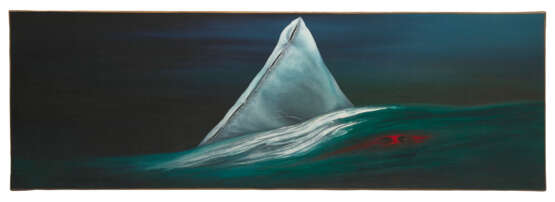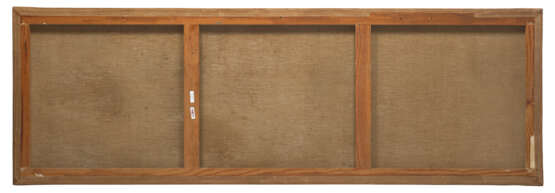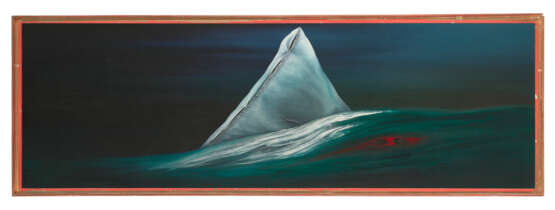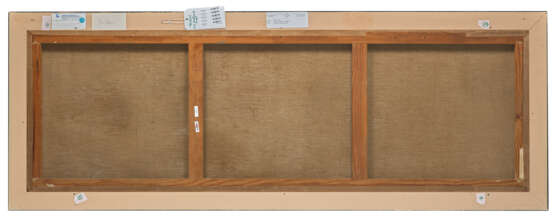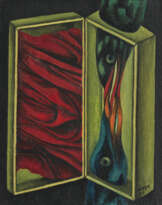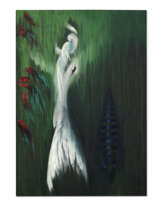ID 1302122
Lot 46 | Toyen (Marie Cermínová, dite; 1902-1980)
Estimate value
€ 800 000 – 1 200 000
Flux et reflux de la nuit
signé et daté ‘TOYEN 55’ (en bas à droite); signé, daté et inscrit '45.5 x 148 TOYEN FLUX ET REFLUX DE LA NUIT 1955' (sur le châssis)
huile sur toile
50 x 150 cm.
Peint en 1955
signed and dated 'TOYEN 55' (lower right); signed, dated and inscribed '45.5 x 148 TOYEN FLUX ET REFLUX DE LA NUIT 1955' (on the stretcher)
oil on canvas
19 5/8 x 59 in.
Painted in 1955
Provenance
Charles Estienne, Paris.
Galerie du Pieuré (Françoise Tournié), Carennac.
Acquis auprès de celle-ci en janvier 1975.
Literature
Štyrský, Toyen, Heisler, cat. exp., Paris, Musée National d’Art Moderne, Centre Georges Pompidou, Paris, 1982, p. 59 (illustré).
Exhibited
Saint-Cirq-Lapopie, Château de Saint-Cirq-Lapopie, Hommage à Toyen, 1982.
Paris, Musée d’Art Moderne de la Ville de Paris, Passions privées, Collections particulières d’art moderne et contemporain en France, décembre 1995-mars 1996, p. 222, no. A18.14 (illustré, p. 223; dimensions erronées).
Prague, City Gallery, House of the Stone Bell, Toyen, mai-août 2000, p. 219, no. 294 (illustré en couleurs; dimensions erronées).
Saint-Étienne, Musée d’Art Moderne, Toyen, Une femme surréaliste, juin-septembre 2002, p. 191 et 259, no. 112 (illustré en couleurs, p. 190; dimensions erronées).
Further Details
« Il fait nuit dans la pièce où tremble un oreiller
Comme un voilier qui sent venir la haute mer,
Et je ne comprends pas si je suis l'équipage
Ou l'adieu d'un bras nu resté sur le rivage. »
Jules Supervielle, Le Forçat innocent, 1930.
On ne peut s'empêcher de songer à ces vers du poème Le Forçat innocent (1930) de Jules Supervielle (1884-1960) en contemplant Flux et reflux de la nuit, composition lyrique peinte par Toyen en 1955. Supervielle, bien qu'il n'adhérât guère au surréalisme, fut un membre actif de l'avant-garde littéraire parisienne des années 1940, proche de poètes, écrivains et critiques tels que Jean Paulhan (1884-1968), Henri Michaux (1899-1964) ou René Etiemble (1909-2002). La notion de « flux » et de « reflux » évoque par ailleurs une idée de mouvement perpétuel, d'oscillation entre deux mondes, qui n'est pas sans rappeler la formule de l'écrivaine Annie Le Brun, « l'écart absolu », dont elle fera le titre de la grande rétrospective de Toyen au Musée d'Art Moderne de Paris en 2022.
À l'écart, l'artiste le fut en effet inlassablement, se positionnant toujours à contre-courant des grandes tendances esthétiques de son temps, au profit d'une multitude de recherches plastiques vouées à exprimer le regard singulier qu'elle portait sur le monde : le monde autour d'elle, en elle, et au-delà. La volonté de traduire en peinture la perception poétique des souvenirs traverse l'ensemble de son œuvre, depuis les premières heures de l'« artificialisme », mouvement qu'elle cofonde avec son compatriote tchèque Jindřich Štyrský en 1926. En découle un langage visuel où, selon Whitney Chadwick, « les impressions, les images et les sentiments (vécus ou imaginés) laissent leur empreinte sous forme de traces abstraites et de vives sensations chromatiques » (W. Chadwick, Women Artists and the Surrealist Movement, Londres, 1991, p. 115).
Une trentaine d'années plus tard, et peu de temps après sa période surréaliste, c'est sa vision-même de la vie, très subjective, que Toyen semble cristalliser dans Flux et reflux de la nuit, à travers la métaphore du va-et-vient des vagues s'écrasant contre un oreiller à la dérive dans un intérieur nocturne.
Les tableaux que conçoit Toyen durant les années 1950 présentent bien souvent des éléments organiques, des figures difformes ou des paysages équivoques, comme celui-ci, qui suscitent à la fois le malaise et l'émerveillement. Son approche déroutante de la couleur et des textures intensifie la dimension fantastique de ces œuvres, plongeant l'observateur dans des univers où se confondent illusion et réalité. Ici, elle parvient à traduire toute l'immatérialité du ciel sombre, dont l'aspect éthéré vient trancher avec le rendu étrangement sculptural de ce coussin qui semble fait de marbre plutôt que de molleton. Arrive ensuite un fabuleux déferlement de touches souples et enlevées pour signifier la mer et les vagues, dont le flot paraît emporter l'oreiller dans l'obscurité. En ce sens, Flux et reflux de la nuit illustre pleinement la virtuosité avec laquelle Toyen arrive à mêler un parfum de mystère et une certaine profondeur psychologique à son imagerie onirique.
Aucun critique n'a mieux saisi la richesse de la démarche artistique de Toyen que son amie proche, femme de lettres et poétesse, Annie Le Brun. Celle-ci écrit dans l'introduction du catalogue d'exposition Toyen, L'Écart absolu : « Toyen va déserter toutes les voies balisées. En ce sens, personne plus qu’elle n’aura incarné l’'écart absolu' auquel appelait Charles Fourier : 'Colomb, pour arriver à un nouveau monde continental, adopta la règle d’écart absolu ; il s’isola de toutes les routes connues, il s’engagea dans un océan vierge, sans tenir compte des frayeurs de son siècle ; faisons de même, procédons par écart absolu.' En est résulté pour Toyen un voyage sans précédent, au cours duquel la peinture aura été avant tout le prétexte de s’aventurer dans les continuelles mouvances de la représentation, à la seule fin d’y discerner les courants susceptibles de nous emporter au-delà de ce qui est tenu pour réel » (A. Le Brun, in Toyen, L'Écart Absolu, cat. exp, Musée d'Art Moderne de Paris, Paris, 2022, p. 11).
"It is dark in the room where a pillow trembles
Like a sailing ship apprehending the high seas,
And I cannot figure out if I am the crew
Or the farewell of a bare arm left on shore."
Jules Supervielle, Le Forçat innocent, 1930.
In this lyrical composition of 1955 by Toyen titled Flux et reflux de la nuit, one cannot but link it to this passage from Jules Supervielle’s poem, Le Forçat innoncent, of 1930. Although he was not an advocate of Surrealism, Supervielle (1884-1960) was very much part of the Parisian avant-garde literary scene of the 1940s, befriending poets, writers and critics the likes of Jean Paulhan (1884-1968), Henri Michaux (1899-1964) and René Etiemble (1909-2002). Moreover, the notion of ‘flux et reflux’, or ‘ebb and flow’ connotates a constant movement, an oscillation or fluctuation between two worlds, which was coined by poet and author Annie Le Brun, in the title of the major Toyen retrospective show that was held in Paris in 2022, L’écart absolu, or ‘Absolute divergence’. Indeed, Toyen’s oeuvre is a permanent divergence from any mainstream art trend as she explores endlessly the world around her, within her, beyond her through different stylistic means. Ever since she had co-founded with fellow Czech artist Jindřich Štyrský the movement known as Artificialism in 1926, she had this fascination with translating into painting the poetic perception of memory in which, as Whitney Chadwick writes: ‘impressions, feelings, and images – lived or dreamed – leave their imprint in abstract traces and vibrating colour sensations’ (W. Chadwick, Women Artists and the Surrealist Movement, London, 1991, p. 115). Thirty years down the line, and after her Surrealist years, Toyen crystalizes her own perception of life, through the metaphor of the ‘ebb and flow’ of the waves crashing against what seems to be a cushion in the night in her painting Flux et reflux de la nuit.
Indeed, Toyen's paintings from the 1950s often feature organic forms, distorted figures, and ambiguous landscapes that evoke a sense of unease or wonder, emblematized by the present work. Her extraordinary use of color and texture further enhances the surreal atmosphere of her works, inviting viewers into a world where reality and fantasy blur. Here, she succeeds in conveying the dark sky’s immateriality, contrasting with the cushion’s surprisingly sculptural aspect as opposed to the plushness one would expect from a cushion. Toyen then creates a wonderful flow with her rich brushstrokes for the rendering of the sea and the waves that seem to transport the cushion through the night. Flux et reflux de la nuit truly exemplifies Toyen's ability to merge dream-like imagery with a sense of mystery and psychological depth.
No other critic than Annie Le Brun, a well-known poet but also a close friend of Toyen, has better described the depth of Toyen’s artistic approach. In her introduction to the 2022 exhibition catalogue titled Toyen, L’écart absolu (Toyen, Absolute Divergence), she writes: "Toyen went off the beaten track. In this sense, no one more than she embodied the "absolute divergence" to which Charles Fourier had referred to: "Columbus, in order to reach a new continental world, adopted the rule of absolute divergence; he isolated himself from all known routes, he embarked on an empty ocean, without taking into account the fears of his century; let us do the same, let us proceed by absolute divergence". The result for Toyen was an unprecedented journey, during which painting was first and foremost a pretext for venturing into the continual evolutions of representation, with the sole aim of discerning the trends likely to carry us beyond what is held to be real" (A. Le Brun, in Toyen, L'Écart Absolu, cat. exp, Musée d'Art Moderne de Paris, Paris, 2022, p. 11).
| Artist: | Toyen (1902 - 1980) |
|---|---|
| Applied technique: | Oil on canvas |
| Auction house category: | Paintings, Watercolors, Drawings, Paintings |
| Artist: | Toyen (1902 - 1980) |
|---|---|
| Applied technique: | Oil on canvas |
| Auction house category: | Paintings, Watercolors, Drawings, Paintings |
| Address of auction |
CHRISTIE'S 8 King Street, St. James's SW1Y 6QT London United Kingdom | |
|---|---|---|
| Preview |
| |
| Phone | +44 (0)20 7839 9060 | |
| Buyer Premium | see on Website | |
| Conditions of purchase | Conditions of purchase |

